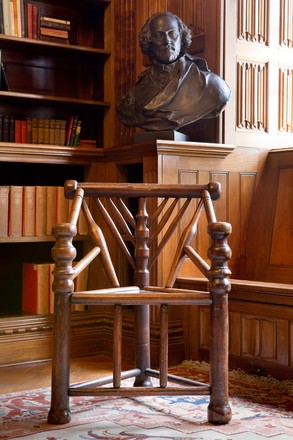‘Shakespeare’s Wood’ chair
1800s
English oak with mulberry insertion
Bequest of Bertram Howell, 1961
Embedded in the top rail of this unusual three-legged chair is a slip of mulberry wood stamped with the words ‘Shakespeares wood.’ It is believed that this piece of wood is from a mulberry tree which Shakespeare planted in his garden at Stratford-upon-Avon.
The armchair is made from three upright posts, which support a flat, triangular seat made from a single plank housed within a triangular frame. Each post has numerous turnings which terminate in ball finials and feet. All are joined below the seat by turned cylindrical stretchers. Supporting the cylindrical top rail, either side of the back post, are six small slanted spindles with tapered turnings decorated with simple incised grooves forming a back rest, while the turned cylindrical arm rests run from each end of the top rail to below the ball finials of the front uprights. Each arm is supported by a large turned spindle fixed into the triangular seat frame. The design is based on the earlier Edward III style, popular in the 14th century.
Wobble-proof
Chairs with three legs are well suited for use on uneven floors as they do not wobble. They were popular from the 1400s, becoming increasingly more complex in design and construction.
The technique used to make this chair has been used since ancient times. The wood is shaped using a cutting or gouging tool such as a chisel, while it is turned on a lathe driven by pulling on a length of cord attached to a pole. Prior to the 1550s, pieces of turned furniture were almost always very plain, made of simple cylindrical posts decorated with a few incised grooves. These became more numerous, stylish and elaborate by the 1600s.
The continuing use of three-legged furniture has meant that it can be difficult to date accurately, especially as turned furniture remained popular with furniture collectors into the 19th-century.
A lucrative trade
And from his touchwood trunk the mulb’ry tree
Supplied such relics as devotion holds
Still scared and preserves with pious care
William Cowper, 1785
The slip of fruit wood stamped ‘Shakespeares wood’ forever brands this chair as part of the highly lucrative souvenir industry that developed around playwright William Shakespeare and his home at Stratford-upon-Avon in south Warwickshire. But one event in particular created an entirely new genre of Shakespeareana and sparked a collecting frenzy that would last for centuries: tired of the stream of visitors to Shakespeare’s last home, New Place, in 1756 a cantankerous neighbour, the Reverend Francis Gastrell, chopped down a mulberry tree said to have been planted there by Shakespeare himself.
The wood was sold to a local clockmaker, Thomas Sharp, who immediately saw a business opportunity in converting the tree into knick-knacks stamped ‘Shakespeare’s wood’. Not surprisingly, these mulberry wood souvenirs were eventually produced in numbers far in excess of the amount of timber originally purchased, but regardless, they were much prized and held up to great acclaim. The trade flourished into the 19th century, when John Marshall, a Stratford carver and antiquarian, sold articles carved from wood said to be associated with Shakespeare from his shop next door to the New Place site.
True or false?
During the 19th century the demand for Shakespeare memorabilia with links to the mulberry tree in his garden skyrocketed, and a new market of counterfeit Shakespearean wooden goods emerged. Shakespeare experts were soon confronted with the questions:
Does wood from trees grown from slips of the original mulberry tree count as genuine?
Is an object marked ‘Shakespeare’s wood’ actually made from the tree?
Because far more objects than could possibly be genuine have been represented by dealers as being manufactured from Shakespeare’s mulberry tree, it is increasingly difficult to assign any authenticity to the original items or to distinguish forgeries from the originals. Traditional Shakespearean relics are meant to establish a connection to the poet’s own life story, but even collectors are known to have paid large sums for these items because they provided a link, however indirect, to Shakespeare the man.
Sydney’s slice of Shakespeare
A slip from the original mulberry tree
is said to have propagated the mulberry tree that flourishes in the central
lawn of the New Place garden to this day. A slip from the original tree was
also propagated at Troston Hall, near Bury St Edmonds. This tree lived for more
than a century and is said to be the source of many cuttings that still survive,
including the scion presented to the Royal Botanic Gardens at Kew in October
1896. In March 1915 David Prain (then director) wrote:
We have
propagated from it rather freely, have planted various off shoots from it in
various parts of the garden and have sent plants to places where there are
memorials of Shakespeare and to people interested in matters relating to him.
The mulberry tree planted in Sydney’s Royal
Botanic Gardens is a direct descendant the tree that stands in the Kew Gardens,
London.



 Back to list
Back to list